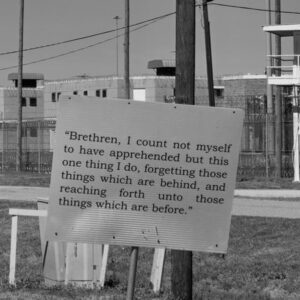
Is Masculinity a Terrorist Ideology?
Lacy Johnson on Rachel Louise Snyder and the Ways We Name Violence
A few weeks ago, on a night when my husband was putting our children to bed, I came across a news headline announcing that a local man had pleaded guilty to murdering his wife and cremating her on a pyre he made from 100 pounds of charcoal. He collected her ashes and left them in a plastic bag on the curb, the story claimed, but when the trash collectors left it behind, he took the bag to work and disposed of it there. The district attorney called the details of the case “disturbing,” especially because there was no history of domestic violence at the home. At least, there was no public record of such a history.
The next afternoon, while driving home from work, I heard on the radio that police had found the bodies of a man and his wife, both dead of gunshot wounds, though only his were self-inflicted. Police called it a “possible murder-suicide” though offered no thoughts on a potential motive. He had no criminal record, they said.
Four days later, on April 9, while I was in the lobby of my doctor’s office, I saw on the morning news that a local man had been arrested in Louisiana for shooting his wife to death in their home and fleeing the state. “And next up,” the newscaster said cheerfully, “we have Tom with the weather.”
The particular history of my life compels me to pay attention to news of crimes like these when they appear in the headlines as “domestic homicides” and when they are later calculated in the broader sea of domestic violence statistics. I spent two and a half of the worst years of my life in a relationship with an abuser, so I know that not every act of domestic violence becomes fatal, and not all fatal violence makes it on the news.
I also know, from having paid attention to these stories nearly half my life, that a single week when at least three men murder their wives within a 30-mile radius of where I live is not special or unique. Each week, about 20 women in this country are murdered by their current or former domestic partners. Today alone—if it is a typical day—more than 20,000 calls will be made to domestic violence hotlines nationwide. During the one minute it has taken to read this paragraph, 20 people have been physically abused.
Domestic violence touches all parts of society—no demographic is exempt from this. The man who abused me was a graduate student at a state university, but abusers can also be police officers or truck drivers; they can be hedge fund managers or football players; they can be beloved teachers or award-winning actors. They can even be President of the United States.
Could it be that masculinity itself is a violent ideology?
This is not to say that men cannot also be the victims of domestic violence—they can, and are, because domestic violence can occur in any relationship regardless of its gender configuration—but, statistically speaking, most abusers are men and most victims are women. Some studies claim that, on average, one in four women will experience severe abuse from an intimate partner at some point in her life. Others suggest one in three. The various forces—both public and private—that keep domestic violence hidden make any measure of this epidemic unreliably low. And if it is unclear what percentage of women have been or will become victims of intimate terror, it is even less clear what percentage of men act as its culprits. A fourth of men? A third? More or less than this?
*
In No Visible Bruises—Rachel Louise Snyder’s new book-length investigation of domestic violence—she writes that after having spent several decades reporting on violence and human rights abuses in Cambodia, Afghanistan, Niger and Honduras, she realized just how vast and hidden the scale of this epidemic is:
…women, in every country, were brutalized and controlled by men as a matter of routine. Men made the rules, primarily through physical violence. It was there lurking in practically every story I’d ever covered across the world, a shadowy background so obvious I didn’t even have to ask about it most of the time. It was as common as rain.
Snyder begins with the story of Michelle and Rocky Mosure, a relationship that produced two young children by the time Michelle was 17, and which devolved over years as his escalating violence, drug use, and emotional coercion slowly isolated her from everyone she knew. When she was 22 and finally resolved to leave him, he murdered her and their two young children in their home before turning his guns on himself. The murder shocked the entire community. Her parents, his parents, the police and prosecuting attorney and even the judge wonder aloud to Snyder what they missed, claiming they couldn’t possibly have foreseen what he would do.
Snyder also recounts the similarly horrifying murder of Dorothy Giutana-Cotter by her husband William—after she resolved to leave him, he shot her and himself in front of their 11-year-old daughter while she was on the phone with police—as well as the myriad abuses suffered by a chorus of other pseudonymous women who have been battered, beaten, pistol-whipped, strangled, gaslit, kidnapped, and terrorized by a current or former boyfriend or spouse. As Snyder points out, it isn’t particularly useful to ask why these victims stay because very little about the way we treat domestic violence in our communities makes it possible to leave—victims are often economically dependent on their abusers; their abusers tend to isolate them from their family and friends and any potential pathways to escape; abusers have legal rights to their homes and property and children, but victims do not have legal rights to their emotional health. Additionally, some abusive acts, such as stalking by an intimate partner, are not illegal, especially not for the first offense. It is also not illegal for an abuser to control his partner’s access to the phone, to surveil her every move, to threaten to kill her and her children if she leaves. On the rare occasion that police intervene, “victims often side with their abusers,” Snyder writes. “Because long after the police leave, even after charges are filed and a sentence meted out, it is with the abuser that a victim must continually negotiate her life.”
The hiddenness of these negotiations is one of the things that can so often lead an abusive relationship to become a fatal one, Snyder argues, and though that paints a stark picture of reality for many victims, Snyder does acknowledge the important and ongoing work of domestic violence activists, advocacy organizations, and social workers, to train police officers and emergency medical professionals to “see” evidence of a victim’s peril in absence of her cooperation: bloodshot eyes, a raspy voice, slurred speech, and burst blood vessels in the cheeks are visible evidence of strangulation, for instance, and strangulation by an intimate partner often precedes being killed by them. A gun in the home makes it five times more likely that a woman will be killed by her husband or intimate partner. An attempt to leave him increases the likelihood he will kill her by 75 percent.
Terrorism, these images tell us, is infrequent, far away, and visible, but in reality most violence is common, nearby, and hidden.
Snyder asks how these murdered women might have survived—learning along the way that women are more likely to survive if they have somewhere to shelter with their children, if they can avoid contact with their abuser, if they can become economically independent—but never quite finds an answer to what might be a more pressing question: what makes so many men become violent in the first place? The men Snyder interviews—many of whom are reformed abusers—suggest that domestic violence is part of a greater cycle of violence and abuse: men abuse others because they themselves were abused; men are violent because manhood itself is violent. “It is men who take their violence out on masses of others,” Snyder writes. “Mass murders. Gang warfare, murder-suicides and familicides and matricides and even genocide: all men. Always men.”
*
Could it be that masculinity itself is a violent ideology? Recently, the American Psychological Association acknowledged the connections between “masculine ideology” and a “particular constellation of standards that have held sway over large segments of the population, including: anti-femininity, achievement, eschewal of the appearance of weakness, and adventure, risk, and violence.” According to this report, masculine ideology demands that men and boys suppress vulnerability and human connection, restrict their emotion to only confidence or aggression; value themselves in terms of their power over others, and accumulate power through intimidation and force. Masculine ideology is linked to homophobia, bullying, sexual assault, and intimate partner violence.
A far more accurate word to describe what these relationships must feel like from the inside, Snyder suggests, is “terrorism.”
“Intimate partner violence” is, as Snyder points out, a euphemism—much like “domestic violence,” “private violence,” and “spousal abuse”—that fails in important ways for being too heteronormative, too limited, too elusive, and these failures obscure the “particular constellations” of power and force at work in these relationships. A far more accurate word to describe what these relationships must feel like from the inside, she suggests, is “terrorism.”
Terrorism might seem like the wrong word to use for the violence many people still consider “a private matter,” given that the legal definition of terrorism remains unclear—the UN remains unable to agree on a single working definition—and that acts of domestic terrorism, especially the terrorism of white men, are not prosecuted as such by the courts. For nearly the last 20 years our collective memory of terror has largely been informed by the attack against the World Trade Center—and, increasingly, by images of the horrifying and unforgettable carnage of suicide bombings and mass shootings, both here and abroad. These images horrify us, and their horror makes them persuasive, so much so that most Americans seem ready to accept that the greatest threat to our security is one that comes from an elsewhere—an over there—rather than from within our own homes.
Terrorism, these images tell us, is infrequent, far away, and visible, but in reality most violence is common, nearby, and hidden. In 2016, for instance, terror attacks claimed the lives of 68 people in the United States—but that same year, more than 1,800 women were murdered by men, and 93 percent of murdered women were killed by men they knew. That year wasn’t unique or unusual in this regard; again and again, decade after decade the statistics bear out: more than half of the women killed in this country are murdered by current or former intimate partners, and always the person most likely to be killed by a man with a gun isn’t a terrorist or a serial killer or even a burglar—it’s himself and his family.
Terrorism, if it also includes all of this, is a large and unwieldy threat, and makes the connection between private, hidden acts of violence and public, visible ones unmistakable. Adam Lanza, for example, killed his mother in her bed before murdering 20 first-graders and five elementary school staff in 2012; Stephen Paddock was well-known among casino staff for berating his girlfriend in public before he opened fire on concert-goers on the Las Vegas Strip in 2017. James T. Hodgkinson, who shot Rep. Steve Scalise and four others at a baseball practice in Washington, DC, repeatedly abused his daughter and then punched his neighbor in the face when she threatened to call 911. Omar Mateen, who murdered 49 people at the Pulse nightclub in Orlando in 2016 had, years earlier, battered his wife and held her hostage, though he was never held criminally accountable for this. Men who are radicalized by masculine ideology terrorize their families, and a man who terrorizes his family is more likely to terrorize strangers.
The weapon he is most likely to choose is a gun, but sometimes he uses only his hands. Last August, in Colorado for example, Christopher Watts strangled his pregnant wife and two daughters when she discovered he was having an affair, before dumping their bodies at a worksite. In 2017, in Houston, Steven McDowell strangled his ex-wife on the eve of Hurricane Harvey, and attempted to use the storm to cover his tracks. Donald Trump famously attacked his ex-wife, Ivana, according to a sworn affidavit submitted during divorce proceedings. After a painful scalp reduction surgery, the affidavit says, he ripped out her hair in a fit of rage and violently raped her, asking her afterward, “Does it hurt?” She later recanted this testimony—a behavior that is consistent with many victims’ strategy for survival—but years later we can see and hear in his actions and words that he terrorizes people every day. He tells women they are “worthless,” “stupid,” they are “dogs” and no one should believe what they say. He says that foreign nations are “shithole countries,” that Islam is “evil,” and that asylum seekers are “dangerous animals.” I think of the crisis at the southern border as a visible form of the abuse he inflicts on the bodies of men and women and children in unseen ways every single day.
The reality of the terror these men inflict is obscured by the cultural attitude that domestic violence is private—even when it becomes fatal, even when it claims the lives of an entire family, even when there is a clear and unmistakable connection between the intimate terror that happens behind closed doors and the public terror that occurs at a church, or a concert, or at a border crossing, or on a crowded street.
*
Recently I was at a literary event where a man came in late and immediately became disruptive by moving a chair into the aisle and in front of other audience members. When they asked him to move he shouted at them and at the volunteers who approached him. He shouted out his question after the time was over for the Q&A. Afterward, he came to the stage to confront me about something I had said—as men often do—shouting in my face and pointing his finger at me until one of my fellow panelists—a man—chose to place his body between this man and me, telling the disruptive man in a low voice that his actions were not appropriate and he needed to leave.
Seeing a problem is not the same thing as addressing it, and to address it we must call it by its name.
My question is this: why was this man permitted by everyone present, save one—a hundred people maybe—to behave in this way? He was old and white, which gave him some protection no doubt, but he was also shouting and belligerent. Why didn’t other men—or anyone really—recognize the familiar menace in his actions and behavior and intervene?
Sometimes I think of all the people who knew what my abuser was doing to me or was capable of doing to me but said and did nothing: our neighbors, whom I could hear washing silverware through the parchment-thin walls, never said a word about the slurs he shouted at me, or the slammed doors, or the unmistakable thud of my body hitting the wall or the floor; his mother and father and brothers, who knew his former wife had left him because he kidnapped their children and tried to kill her; my friends who fell out of touch because they were afraid of him; the technician who sold him soundproof insulation for the room where he planned to kill me; the friend who hid him in the basement so he could evade police and leave the country; even the government of Venezuela, which shelters and protects him to this day—all bystanders who aided and abetted his violence with a veil of privacy and privilege, and who perhaps share a small part of his blame.
Men who abuse aren’t “monsters”—nor are they, as Rachel Louise Snyder suggests, part “bear.” Violence isn’t an inevitable part of men’s lives, but rather a set of choices, actions, attitudes, and the permissions we give to allow them to go on being violent in a thousand different ways. And though masculine ideology forms the structure of every part of our society, men—those like my fellow panelist—can choose to work toward dismantling it by choosing vulnerability over violence, care over control. Men can choose to reduce the harm that masculine ideology does to us all.
Actions matter, and words matter too. Whatever euphemisms we use to describe the terror of it, violent men are the second leading cause of death for women under 45 every single day. Perhaps there will eventually be a shift in this, because even to be able to acknowledge that everywhere, all across America, men are radicalized by an ideology that terrorizes women in systemic and uncoordinated ways, implies that the threat is becoming less hidden, more visible, and if it is becoming visible it can be seen. Seeing a problem is not the same thing as addressing it, and to address it we must call it by its name.
Lacy M. Johnson
Lacy M. Johnson is a Houston-based professor, curator, activist, and is author of the essay collection The Reckonings, the memoir The Other Side — both National Book Critics Circle Award finalists — and the memoir Trespasses. Her writing has appeared in The New Yorker, The New York Times, the Los Angeles Times, Virginia Quarterly Review, Tin House, Guernica, and elsewhere. She teaches creative nonfiction at Rice University and is the Founding Director of the Houston Flood Museum.












